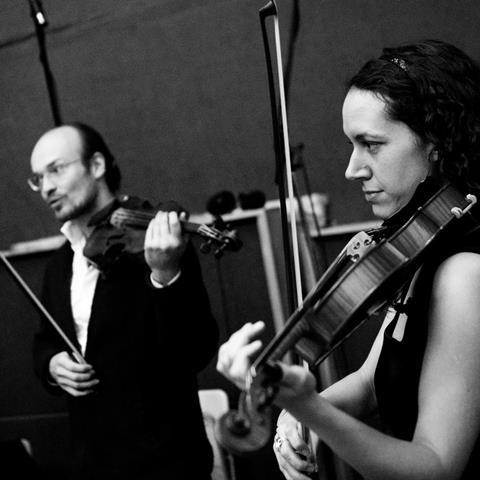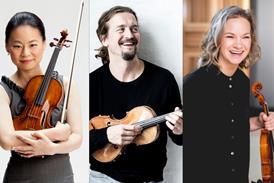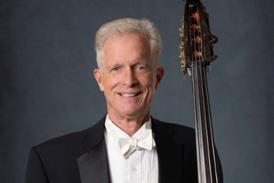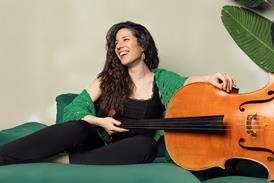London Tango Orchestra director and violinist Caroline Pearsall demonstrates tango music effects

Tango effects
These 'effect' techniques are a lot of fun and are often the first thing people like to learn. Most of them are pretty easy but others may take some practice.
1. Chicharra
For this technique you should play on the coloured cotton on the D string behind the bridge. Make sure the bow has been rosined recently, and place the heel of the bow on the string. It will make a rough percussive sound which we often use to accompany rhythmic moments.
2. Tambor
This is a form of pizzicato where the fingers of the left hand are placed differently. You put the second finger of the left hand on the D string where you normally play G# but you place the finger so the fleshy edge is near the G string. You then pluck the G string quite hard and the string should rebound off your finger creating a dry drum-like sound. You shouldn't hear any harmonics or notes; it should be totally dry.
3. Latigo
This means whip. It's a kind of fast ascending glissando that often finishes on a harmonic. It often covers the length of the fingerboard. You can also do short versions in a descending direction that start high up on the E or A strings.
4. Sirena
This means siren – like the old war sirens. You play a double stop on any two strings, start high and slowly slide down. It often slides into silence and can be very effective if used sparingly in atmospheric tangos like some of Piazzolla's.
5. Cepillo
This means brush. You start with the bow over the fingerboard and move it at a 90 degree angle up to the bridge. This makes a kind of scratching or brushing sound that you can use to start rhythmic chords and notes. Ramiro Gallo uses this a lot.
6. Golpe de Caja
This means 'to hit on the box' - the box being the body of your instrument. It's often used on bass and cello and it's also possible on the violin. You can hit in a variety of different ways - with your thumb, your knuckles or palm of your hand. Each produces a different sound.
7. Strapata
This is for double bass and cello only as it doesn't really work on the shorter string lengths of violin and viola. You hit the strings with the bow at high speed, either with the hair or col legno and let it bounce, slamming your hand down over the strings at the end to create a drum roll type sound. It's pretty cool!
8. Banjo Pizz
This is only used when playing violin. It's a kind of rolling pizz before the actual note. You can use one or two fingers from the right hand.
9. Milonga Pizz
This is used only in milongas and you play pizzicato on the strings behind the bridge.
10. Back Crunch
This is when you press the bow down on the back of your instrument and roll the wood of the bow across the hair from side to side. It sounds like something is cracking and breaking - I love doing it for classical violinists and seeing the horror on their faces! It doesn't do any damage - just leaves a bit of rosin on the back of your instrument which can be wiped off.
11. Arrastres
This is a technique used extensively by the piano and bass. It's basically an upbeat effect and is mostly used with sincopas to exaggerate their effect. You place the bow and fingers lower than the note you want to finish on and slide both up together creating a kind of crunchy gliss sound that you finish with an accent. This is used by all tango bands.
12. Brazilian Squeak
This sound resembles the squeaky noise made by a small type of Brazilian drum. You place your fingertips on the back of your violin or cello and with a swift movement bring them up towards you along the back of the instrument. If you fingers are too dry the technique won’t work.
http://www.thelondontangoorchestra.com/
Read: The art of the violin slide
Read: Esther Yoo’s practice tips: chord pizzicato
Read: 7 pointers for perfect pizzicato
Explore more Technique articles like this in The Strad Playing Hub


































No comments yet